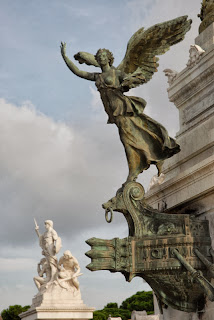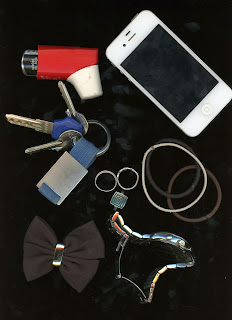mercoledì 30 ottobre 2013
Kristen - Lomography
Lomography:
a community and movement of photographers who specialize in creative and experimential film photography
The Lomographic International Society was founded in 1992 by a group of students from Vienna. The name of the movement came from a Russian film camera called the LOMO LC-A Compact Automat camera. The Viennese students decided to create the society because they were in love with the "unique, colorful, and sometimes blurry"images that the camera produced. The main characteristics of photos produced by this camera and its analogs have unusual saturation and color, which is achieved using a developing technique called cross processing. Digital editing software can mimic this type of photography, but this is obviously discouraged by the Lomographic community.
a community and movement of photographers who specialize in creative and experimential film photography
The Lomographic International Society was founded in 1992 by a group of students from Vienna. The name of the movement came from a Russian film camera called the LOMO LC-A Compact Automat camera. The Viennese students decided to create the society because they were in love with the "unique, colorful, and sometimes blurry"images that the camera produced. The main characteristics of photos produced by this camera and its analogs have unusual saturation and color, which is achieved using a developing technique called cross processing. Digital editing software can mimic this type of photography, but this is obviously discouraged by the Lomographic community.
 |
| The original Lomo LC-A |
martedì 29 ottobre 2013
At War: photographer Don McCullin
http://www.youtube.com/v/OVZe4rQKcls?autohide=1&version=3&autohide=1&feature=share&attribution_tag=iCMHOJ7JHuOZCwXolh1njA&showinfo=1&autoplay=1
William Eggleston - Imagine Documentary - Part 5
http://www.youtube.com/v/dmUT3O9xrPw?version=3&autohide=1&feature=share&autohide=1&attribution_tag=Df95w7NFkyI4guaFYoBLXw&showinfo=1&autoplay=1
William Eggleston - Imagine Documentary - Part 4
http://www.youtube.com/v/8nhDS_pDyz0?autohide=1&version=3&attribution_tag=gBEF0AcWb_0piIWcQHHa3Q&autohide=1&autoplay=1&feature=share&showinfo=1
William Eggleston - Imagine Documentary - Part 3
http://www.youtube.com/v/oQx4GTPa-p4?autohide=1&version=3&attribution_tag=wztBUYEaHo-pcSSf9Dm8_Q&autoplay=1&showinfo=1&feature=share&autohide=1
William Eggleston - Imagine Documentary - Part 2
http://www.youtube.com/v/UVm8S7mB23o?version=3&autohide=1&showinfo=1&autoplay=1&feature=share&attribution_tag=y8q4p5mA7pUskNuqOnvBag&autohide=1
William Eggleston - Imagine Documentary - Part 1
http://www.youtube.com/v/gGR6_H-G17c?version=3&autohide=1&feature=share&autoplay=1&autohide=1&showinfo=1&attribution_tag=J6x2D6PPpO1e_P5EkAyUtQ
Priscilla
I straightened this picture
I enhanced the colors and increased the contrast
I boosted the colors and warmed up the temperature
domenica 27 ottobre 2013
TEST for AS 289/2
______________________________________________________________________________________
Part
I. Technical
Review (40 points)
Suppose your camera has the following settings:
aperture f1.8 f2.8 f4
f5.6 f8 f11
f16 f22
shutter B 1
2 4 8
15 30 60
125 250 500
1000
(It is a manual slr film camera with a 50mm 1:1.8 lens.)
- Which f-stop allows the most light in?
- Which allows the least?
- Which will give the most depth of field?
- What does depth-of-field mean?
- Where is the aperture diaphragm located?
- How is aperture measured?
- Which f-stop allows half the amount of light as f5.6?
- Which allows twice the light as f5.6?
- What does focal length refer to?
- Besides aperture, what is another factor that affects depth of field?
- Where is the depth of field scale located (on a traditional slr)?
- What is the shutter and what does it control?
- How is shutter speed measured?
- Where is the shutter located?
- What kind of shutter speed is needed in low light conditions?
- What does “B” refer to?
- What is the safest slow shutter speed without a tripod?
- Which ss allows twice as much light as “60”(1/60)?
- Which allows half as much light as “60”?
- (4 points) On a given day, your camera gives you a correct reading of f4 at 250. What other configurations would give you the same amount of light and a greater depth of field? (list four ways).
- Which would give you the same amount (as above) of light and allow you to create a blurred picture of a speeding car?
- Which shutter speed would give you the same amount of light (as above, question 20) at f2.8?
- On a shadowy area with a bright sky, how would you insure a correct exposure of a subject in shadow?
- (4 p)Which is a better setting, f4 at 1/60, or f 16 at 1/4 ? Say why.
- What does ISO refer to?
Iscriviti a:
Commenti (Atom)





























 I
I


















